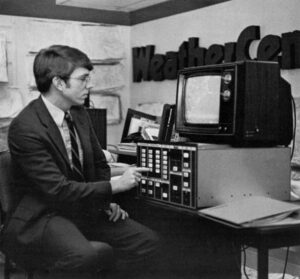
Every new hurricane that touches North Carolina soil always evokes a name, memory, and comparison of previous storms: Hazel, Floyd, Fran, and now Irma. When it comes to covering hurricanes, we know a thing or two, or three, or four…
In 1984, Hurricane Diana was compared to Hurricane Hazel of 1954 simply because Diana reared her ugly head with the same devastation as Hazel’s havoc. In our CBC History archives and video vault, we unearthed a CAPCOM article and a video. The video is a compilation of the news coverage that aired on Action News 5. Click on the link below to watch it.
Coverage of Diana provides an important data point in the growth of Capitol Broadcasting. CBC was more than television and radio in ’84. It had become a leader in the telecommunication industry. When Hurricane Diana roared up the coastline, CBC was poised with an assortment of communication arrows in its media quiver. All CBC resources, human and technical, would be tested against Diana’s fury.
 Greg Fishel checking out the RADAC system.
Greg Fishel checking out the RADAC system.
In 1984, one of the new pieces of technology in the WeatherCenter was RADAC. It allowed our meteorologists to graphically access more than 100 weather radar sites across the country. Shortly after RADAC was installed, Hurricane Diana came calling off the shores of North Carolina. Chief meteorologist Greg Fishel said, “We used the 16-frame storage capacity of the RADAC system and time-lapsed the movement of the eye of Diana. This gave our viewers an incredible look at the storm while aiding all of us in predicting the storm’s eventual movement.”
The following is from THE CAPCOM newsletter, September 27, 1984.
The staffs at WRAL-TV, WRAL (FM), the WeatherCenter, the North Carolina News Network (NCNN), and Capitol Satellite and Communications Systems (C2S2) went on hurricane alert on Sunday, September 9 and didn’t come off it until Friday, September 14 when the storm abated and moved back out to sea. The center of the storm’s activity was approximately 150 miles from Raleigh which created many logistical and technical problems that were successfully overcome by the various CBC staffs.
WRAL-TV’s coverage of the storm involved practically everyone on the staff. The entire news department (40 plus in number), [note: production personnel, directors, graphics were not part of news at that time] and everyone in operations, programming, and engineering (60 plus people) at one time or another played a part in the coverage of the storm not only on WRAL-TV but the Carolina News Network as well. The station presented hourly live reports on the storm for 50 hours and also aired a 30 minute special on September 13. Also on Thursday the station provided a telephone “Helpline” for the public with approximately 15 staffers manning the phones. The WeatherCenter (Greg Fishel, Bill Schmidt, and Bob Debardelaben) worked steadily through the whole week providing information for TV, radio, and the network. The WeatherCenter was the first to accurately predict the path of the erratic storm and to warn residents in the path of the storm to move. Because of the live continuous coverage of the storm, many people on the TV staff worked around the clock during the week. Long time staffers at the TV station agree unanimously that the staff effort put forth during the days of the storm produced the most extensive and complete television coverage of any event in the history of the station.
WRAL(FM) and NCNN, during 52 hours of almost continuous coverage, utilized approximately 20 people to provide broadcast reports on the storm. WRAL(FM) increased its daily news reports from 15-47 and NCNN provided 48 daily newscasts rather than the normal 16. Those assisting during this period were David Guth, Debra Craig-Ray, Jay Joiner, Steve Shumake, Donna Jones, Nancy Lyons, Eric Burch, Pamela Hart, Ron Colbert, Ralph Gordon, Dave Collins, Tom Britt, Keith Harrison, Dick deButts, and Al Mangum.
C2S2 provided approximately 52 hours of feeds to 11 different clients including ABC, CBS, CNN and Public Television. The feeds were virtually continuous during this period for ABC, while CBS took 21 hours and CNN 18 hours. Providing the manpower were Steve Grissom, Marylous Harris, Dave Waters, Tammy Martin, Ed Hubbard, Charlie Bratton, Lee Poole, Richard Danchi, and Harriet Bartnick.
It should be understood that the list of names of CBC people involved in the coverage of the storm is so extensive that it’s impossible to single all of them out, though we’ve attempted to do so where possible. It was a team effort throughout, and everyone involved can be very proud of their efforts.
Like those who remember Hurricane Hazel, in the years to come thousands more will recall Hurricane Diana. Among those thousands will be approximately 200 people at WRAL-TV, WRAL(FM), the WeatherCenter, NCNN, and C2S2.
Indeed we do recall Diana, but the list has grown to include Hugo, Floyd, Fran, Matthew, and Irma. Regardless of the name, the companies that make up Capitol Broadcasting will be there as a first responder in communication.
SLIDESHOW: Images of the damage inflicted on the North Carolina coast by Hurricane Diana
WRAL-TV’s Hurricane Diana Coverage: Adele Arakawa and Charlie Gaddy
WRAL-TV’s Hurricane Diana Coverage
WRAL-TV’s Hurricane Diana Coverage
WRAL-TV’s Hurricane Diana Coverage: WRAL reporter Fred Taylor
WRAL-TV’s Hurricane Diana Coverage
WRAL-TV’s Hurricane Diana Coverage
WRAL-TV’s Hurricane Diana Coverage
WRAL-TV’s Hurricane Diana Coverage: WRAL reporter Shelley Kofler
WRAL-TV’s Hurricane Diana Coverage
WRAL-TV’s Hurricane Diana Coverage: WRAL reporter Tim Kent
Thanks to Corp’s Pam Allen for this capcom story & these photos. Pam Parris Allen is a former WRAL newscast producer/director who now works as a researcher and producer on the CBC History Project.